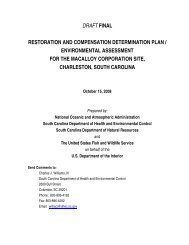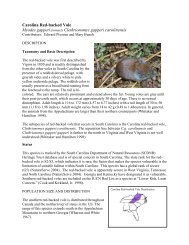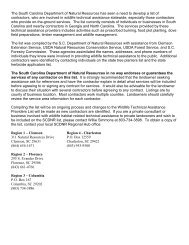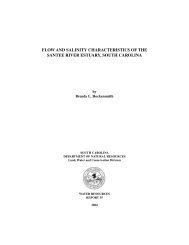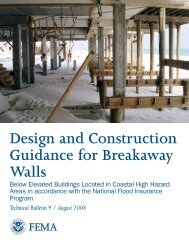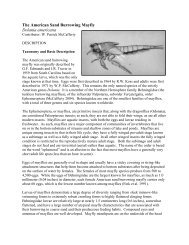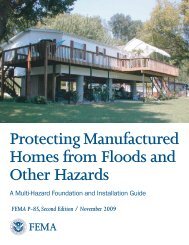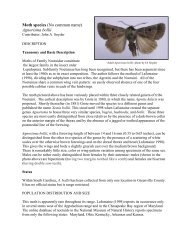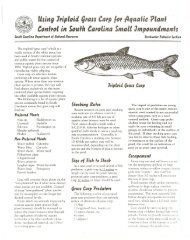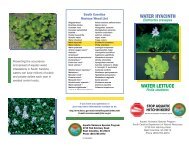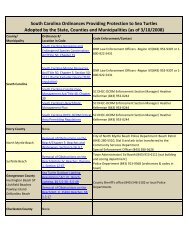Pond Management - South Carolina Department of Natural Resources
Pond Management - South Carolina Department of Natural Resources
Pond Management - South Carolina Department of Natural Resources
Create successful ePaper yourself
Turn your PDF publications into a flip-book with our unique Google optimized e-Paper software.
Managing<br />
<strong>Pond</strong>s for<br />
Recreational<br />
Fishing<br />
<strong>South</strong> <strong>Carolina</strong><br />
<strong>Department</strong> <strong>of</strong> <strong>Natural</strong> <strong>Resources</strong><br />
Wildlife and Freshwater<br />
Fisheries Division<br />
Freshwater Fisheries Section<br />
www.dnr.sc.gov<br />
1
Table <strong>of</strong> Contents<br />
Introduction .............................................................................1<br />
<strong>Pond</strong> Construction....................................................................1<br />
Preparing a <strong>Pond</strong> for Stocking..................................................2<br />
Stocking a <strong>Pond</strong> with Fish........................................................4<br />
Fish Production.........................................................................7<br />
Fishing the <strong>Pond</strong>.......................................................................9<br />
<strong>Pond</strong> Liming and Fertilization................................................11<br />
Water Quality..........................................................................16<br />
Dissolved Oxygen.............................................................17<br />
pH......................................................................................17<br />
Alkalinity and Hardness....................................................18<br />
Aquatic Vegetation Control ...................................................18<br />
Winter Drawdown..............................................................19<br />
Mechanical........................................................................19<br />
Herbicides..........................................................................20<br />
Biological Control ............................................................20<br />
Miscellaneous Problems and Considerations.........................22<br />
Fish Mortality ...................................................................22<br />
Pesticide or Toxic Pollutant Exposure ..............................23<br />
Parasites and Diseases.......................................................24<br />
Muddy Water.....................................................................24<br />
Artificial Fish Feeds...........................................................26<br />
Alligators ..........................................................................27<br />
Snakes................................................................................27<br />
Turtles................................................................................27<br />
Beavers and Other Problem Mammals .............................28<br />
Livestock...........................................................................28<br />
Water Birds........................................................................29<br />
Appendix A: Glossary ..........................................................30<br />
Appendix B: Agencies to Contact<br />
Concerning Fish <strong>Pond</strong>s......................................................32
Introduction<br />
FISHING<br />
is one <strong>of</strong> the most popular participation<br />
sports in <strong>South</strong> <strong>Carolina</strong> and interest continues to grow. A recent<br />
survey by the United States Fish and Wildlife Service showed<br />
that over 609,000 anglers participate in some form <strong>of</strong> freshwater<br />
fishing in <strong>South</strong> <strong>Carolina</strong> and contributed nearly $1.2 billion<br />
to the state’s economy, an indication that fishermen will spend<br />
considerable time and money to enjoy their sport. While the<br />
majority <strong>of</strong> this angling effort<br />
occurs in public waters, the<br />
state abounds in privatelyowned<br />
fish ponds, which, when<br />
properly managed, provide<br />
excellent fishing near home for<br />
a reasonable cost. But good<br />
fishing in ponds seldom just<br />
happens — it takes careful<br />
planning and management.<br />
This publication provides<br />
<strong>South</strong> <strong>Carolina</strong> pond owners<br />
with guidance to increase their<br />
pond’s potential to produce<br />
quality fishing year after year.<br />
<strong>Pond</strong> Construction<br />
A properly managed fish pond can provide<br />
hours <strong>of</strong> angling enjoyment as well as<br />
aesthetic value.<br />
A prudent person would not start building a house without<br />
first designing and planning a structure that suits his needs. A<br />
prospective pond owner should likewise plan a pond that is located<br />
suitably, designed and built properly and that satisfies his fishing<br />
requirements. A number <strong>of</strong> considerations and details that should<br />
be addressed regarding the planning and physical construction <strong>of</strong> a<br />
pond are beyond the scope <strong>of</strong> this guide booklet. Prospective pond<br />
owners should research all available information regarding pond<br />
construction and seek advice provided by state and county agencies<br />
such as the <strong>Natural</strong> <strong>Resources</strong> Conservation Service (NRCS), the<br />
<strong>South</strong> <strong>Carolina</strong> <strong>Department</strong> <strong>of</strong> <strong>Natural</strong> <strong>Resources</strong> (SCDNR) and<br />
the various county extension services.<br />
1<br />
SCDNR Education
Preparing a <strong>Pond</strong> for Stocking<br />
Once construction is completed and the pond basin contains<br />
sufficient water, it is time to stock the fish. Competition from<br />
“wild” fish species is one <strong>of</strong> the major reasons for poor fishing<br />
in <strong>South</strong> <strong>Carolina</strong> ponds. It is important that any fish present be<br />
eliminated prior to stocking, regardless <strong>of</strong> whether the pond is<br />
newly constructed or is an existing pond in need <strong>of</strong> renovation<br />
and restocking. In some instances this can be accomplished by<br />
completely draining the pond and allowing the pond basin to dry<br />
over a period <strong>of</strong> time. In most cases the use <strong>of</strong> a federally approved<br />
chemical piscicide or fish toxicant is required. The chemical most<br />
commonly used for this purpose is rotenone. This compound is<br />
used to kill fish without harming other animals (it affects only<br />
creatures having gills). <strong>Pond</strong>s located on a stream may be subject<br />
to the introduction <strong>of</strong> wild fish entering from upstream but this<br />
situation is largely unavoidable. If rotenone is to be applied to<br />
the pond’s feeder stream, legal issues dictate the application be<br />
restricted to only that stream reach under the direct ownership <strong>of</strong><br />
the pond owner(s).<br />
NOTE: Rotenone is a restricted-use pesticide, which means that<br />
a category 5, <strong>South</strong> <strong>Carolina</strong>-certified applicator license is required<br />
for its purchase and/or use in <strong>South</strong> <strong>Carolina</strong>. Unfortunately, no<br />
feasible alternatives to rotenone are currently available. Therefore,<br />
it is necessary to obtain the assistance <strong>of</strong> a certified applicator. The<br />
use <strong>of</strong> rotenone in ponds located on a stream can pose a number<br />
<strong>of</strong> possible complications including questions <strong>of</strong> legal liability<br />
and environmental responsibility should the material be allowed<br />
to contaminate waters downstream <strong>of</strong> the immediate pond site.<br />
The use <strong>of</strong> rotenone in these situations demands extreme care and<br />
vigilance and should be carried out only by licensed individuals<br />
who have proper knowledge and experience. AS WITH ALL<br />
CHEMICAL PRODUCTS, READ AND FOLLOW ALL LABEL<br />
INSTRUCTIONS.<br />
2
Rotenone should be applied at the rate <strong>of</strong> 6 pounds <strong>of</strong> 5% powder<br />
per acre-foot <strong>of</strong> water. An acre-foot is an acre <strong>of</strong> water one foot<br />
deep. To determine the number <strong>of</strong> acre-feet in your pond, multiply<br />
the number <strong>of</strong> surface acres by the average depth in feet. Be<br />
sure to take into account shallow edges as well as deep holes in<br />
calculating average depth. It is better to actually measure the area<br />
and depths, rather than estimating them. Since the powder does not<br />
dissolve well in water, it should first be worked into a paste with<br />
a small amount <strong>of</strong> water. Gradually add more water until a thin<br />
slurry is obtained. The mixture should then be applied to any water<br />
remaining in the pond, including any potholes or areas <strong>of</strong> standing<br />
water, regardless <strong>of</strong> size. Some fish can survive for extended<br />
periods in nothing more than a deep footprint that contains water.<br />
Liquid rotenone is also available but is <strong>of</strong>ten difficult to obtain.<br />
The 5% liquid formulation should be applied at a rate <strong>of</strong> one<br />
half gallon per acre-foot <strong>of</strong> water. Dilute it enough to cover the<br />
treatment area and apply it in the same manner as the powder.<br />
Rotenone should be applied during the first half <strong>of</strong> September,<br />
so as to allow it to detoxify prior to restocking with hatchery fish<br />
in November or December. The rotenone will detoxify in 7 to<br />
30 days, depending on water temperature. The cooler the water<br />
temperature the longer the chemical remains active. This time<br />
frame will also reduce the time period wild fish can enter the pond<br />
prior to the stocking, should this potential exist.<br />
When renovating a pond, first lower the water level as much<br />
as possible. By doing this, less rotenone will be required and a<br />
more efficient kill will occur. All drain outlets in the pond must<br />
be closed during renovation and until the rotenone is completely<br />
neutralized. Rotenone that escapes downstream is toxic.<br />
REMEMBER, YOU ARE RESPONSIBLE AND LIABLE FOR<br />
ANY DOWNSTREAM EFFECTS!<br />
After applying rotenone, fish should begin to surface within about<br />
5 minutes. A large percentage <strong>of</strong> the fish will surface only once,<br />
then sink to the bottom and rise the next day or the day after as<br />
3
they begin to decompose. The dead fish may be removed from<br />
the pond and disposed <strong>of</strong> in an acceptable manner. If they are<br />
left in the water, no harm will be done except for appearance and<br />
temporary, unpleasant odors. Turtles, birds and other scavengers<br />
will remove many <strong>of</strong> the carcasses.<br />
Stocking a <strong>Pond</strong> with Fish<br />
Young largemouth bass<br />
fingerlings for stocking.<br />
SCDNR FWF<br />
To provide the best recreational<br />
fishing opportunities, only certain<br />
species are recommended when<br />
stocking a pond. These include a<br />
combination <strong>of</strong> largemouth bass,<br />
bluegill and redear sunfish, more<br />
commonly known as shellcracker.<br />
Channel catfish may be stocked<br />
to provide additional fishing<br />
opportunities, but they are not<br />
necessary to maintain a balanced<br />
fish population. The fingerling<br />
fish for stocking may be obtained<br />
Largemouth Bass<br />
from commercial fish breeders licensed by the SCDNR. A list <strong>of</strong><br />
approved vendors is available on the SCDNR web site (www.dnr.<br />
sc.gov) or by contacting one <strong>of</strong> the agency’s regional <strong>of</strong>fices.<br />
Bluegill<br />
Normally, bluegill and shellcracker<br />
should be stocked in the late fall or early<br />
winter. Largemouth bass are stocked the<br />
following spring. If channel catfish are<br />
desired, they should be stocked prior<br />
4
to the bass. Prior to purchasing any fish,<br />
the pond owner should decide whether<br />
or not pond fertilization will be part <strong>of</strong><br />
the future management <strong>of</strong> the pond. This<br />
determines the appropriate stocking rate.<br />
Redear Sunfish<br />
A discussion <strong>of</strong> pond fertilization may be<br />
found on page 11. Fertilized ponds are stocked at the rate <strong>of</strong> 1,000<br />
bream (a combination <strong>of</strong> bluegill and shellcracker at a 3:1 ratio)<br />
and 100 largemouth bass per acre. A pond that will not be fertilized<br />
should be stocked at one half this rate. Channel catfish can be<br />
stocked at a rate <strong>of</strong> 25-50 fish per acre (Table 1). It is critical not to<br />
overstock the pond as this could result in a population imbalance<br />
and dissatisfaction with the fishing it produces. If you wish to<br />
stock species other than those recommended by the SCDNR,<br />
you should first consult with the regional fishery biologist. Some<br />
pitfalls associated with other species that may not be evident to<br />
Channel Cat<br />
Table 1: Recommended species, stocking rates and time for fertilized<br />
and unfertilized ponds.<br />
Fertilized <strong>Pond</strong><br />
Species<br />
Bluegill/ Largemouth Channel<br />
shellcracker bass catfish*<br />
Stocking Rate 1000/acre 100/acre 25-50/acre<br />
Stocking Time Nov-Jan May-mid June Nov- Jan<br />
Unfertilized <strong>Pond</strong><br />
Species<br />
Bluegill/ Largemouth Channel<br />
shellcracker bass catfish*<br />
Stocking Rate 500/acre 50/acre 25/acre<br />
Stocking Time Nov-Jan May-mid June Nov- Jan<br />
*Optional species<br />
5
Golden Shiner<br />
pond managers include a tendency<br />
for some species to over populate or<br />
otherwise compete with the bass/bluegill<br />
population and negatively impact their<br />
successful reproduction and growth.<br />
Two species that are commonly advertised for pond stocking are<br />
crappie and “Georgia giants” or hybrid bream. Crappie do well<br />
in large lakes and reservoirs where water levels <strong>of</strong>ten fluctuate. In<br />
smaller lakes and ponds, their abundance is cyclic or erratic, and they<br />
can overcrowd and cause a severe population imbalance. They also<br />
compete directly with bass and bream for food. “Georgia Giants” are<br />
bream hybrids reputed to have a very high growth rate. Stocked in a<br />
similar manner as bluegills, they are aggressive and bite well. One <strong>of</strong><br />
the hybrid bream’s primary problems is that after several generations<br />
they will genetically revert back to<br />
the original parent crosses used to<br />
produce them which are bluegill<br />
and green sunfish. Green sunfish<br />
are highly competitive and are not<br />
considered a suitable fish for a<br />
recreational fish pond. In order to<br />
maintain the hybrid characteristics<br />
Black Crappie<br />
<strong>of</strong> the “Georgia giant,” renovation <strong>of</strong> the population and restocking<br />
will likely be required about every three years. Most pond owners who<br />
have tried these hybrids in <strong>South</strong> <strong>Carolina</strong> report that the fish falls<br />
considerably short <strong>of</strong> expectations; thus SCDNR does not encourage<br />
their use. In addition, the use <strong>of</strong> shiners as bait is not recommended<br />
due to their tendency to over populate and become competitive with<br />
bluegill, should they be introduced into the pond.<br />
Yellow Bullhead<br />
Wild fish species such as golden shiner, bullhead catfish, crappie and others compete<br />
with the pond’s bass/bluegill population for food, cover and space.<br />
6
Fish Production<br />
In order to successfully manage a recreational fishing pond, the<br />
owner should be aware <strong>of</strong> some basic principles that govern the<br />
status <strong>of</strong> the pond’s fish population and ultimately the quality <strong>of</strong><br />
the fishing. The organic and inorganic nutrients found in every<br />
pond serve as the building blocks for the pond’s aquatic food<br />
pyramid. Simply stated, these nutrients support the microscopic<br />
algae or phytoplankton that are eaten by equally small animals<br />
called zooplankton. Zooplankton is, in turn, eaten by small aquatic<br />
crustaceans, insects and other organisms. These food items are<br />
consumed by bluegill and young bass that ultimately are eaten by<br />
the pond’s larger bass. Properly managed ponds maintain a more<br />
productive food web and have a higher carrying capacity or<br />
ability to support and grow fish than those that are neglected or are<br />
poorly managed. Carrying capacity refers to the maximum weight<br />
(usually expressed in pounds per acre) <strong>of</strong> fish that a pond will<br />
support during a set period <strong>of</strong> time. In highly productive ponds, the<br />
carrying capacity may exceed 300 pounds <strong>of</strong> fish per acre per year,<br />
although most well-managed ponds produce considerably less.<br />
In order to achieve and maintain a balanced fish population, proper<br />
stocking and fish harvest are essential. Balance refers to the ratio<br />
and weight <strong>of</strong> predatory fish (largemouth bass) to forage fish<br />
Angler<br />
(Predator)<br />
Largemouth Bass<br />
(Prey)<br />
Bluegill<br />
Energy Transfer<br />
N<br />
K<br />
P<br />
Aquatic Insects<br />
Juvenile Fish & Snails<br />
Plankton/<br />
Algae<br />
N = Nitrogen<br />
K = Potassium<br />
P = Phosphorous<br />
Aquatic Food Pyramid.<br />
7
(bluegill/shellcracker) in the pond. A well-balanced fish pond can<br />
sustain the growth and reproduction <strong>of</strong> each species, over time,<br />
in the presence <strong>of</strong> angler harvest and natural mortality. The bass<br />
depend on a healthy, reproducing bluegill population for food and<br />
in turn serve to keep the numbers <strong>of</strong> bluegill in check. In order to<br />
maintain a proper balance, the pond should have roughly 3 to 5<br />
pounds <strong>of</strong> bluegill/shellcracker to one pound <strong>of</strong> largemouth bass.<br />
For any <strong>of</strong> a number <strong>of</strong> reasons, a pond’s fish population may<br />
become out <strong>of</strong> balance, including improper stocking, introduction<br />
<strong>of</strong> competitive species, improper harvest, excessive aquatic<br />
vegetation or failure to maintain the pond’s fertility level. Once a<br />
population imbalance occurs, all species are likely to be impacted<br />
and may exhibit symptoms <strong>of</strong> overcrowding, emaciated body<br />
condition and a reduced level <strong>of</strong> reproductive capacity. These<br />
situations ultimately result in poor fishing.<br />
Largemouth Bass<br />
Bluegill/Redear Sunfish<br />
Ratio <strong>of</strong> Prey and Predator.<br />
Maintaining a proper ratio <strong>of</strong> bluegill (prey) and largemouth bass (predator) is essential<br />
to ensuring optimum productivity and growth <strong>of</strong> the pond’s fish population.<br />
8
Fishing the <strong>Pond</strong><br />
Do not begin to fish a newly-stocked pond until June <strong>of</strong> the year<br />
after the bass were stocked (or after the bass have spawned for the<br />
first time). At this time, the bass will generally weigh from one<br />
half to one pound and the bream should weigh approximately one<br />
quarter pound.<br />
One cause <strong>of</strong> poor fishing in <strong>South</strong> <strong>Carolina</strong> ponds is the common<br />
practice <strong>of</strong> “saving” the pond by allowing only limited fishing with<br />
the expectation that this will result in larger and more numerous<br />
fish. This is a serious error and produces an overabundance <strong>of</strong><br />
small, slow-growing fish. The bass/bluegill combination, stocked<br />
at proper rates, depends upon adequate harvest to produce good<br />
fishing year after year. While every pond is unique and the carrying<br />
capacities will vary from pond to pond, annual fish harvest should<br />
be near the following rates:<br />
Table 2: Suggested fish harvest rates for fertilized and unfertilized ponds.<br />
Bream<br />
Bass<br />
Fertilized ponds 75-100 lb/acre/year 18-25 lb/acre/year<br />
Unfertilized ponds 30-40 lb/acre/year 8-10 lb/acre/year<br />
Fish harvest should be spread out over the year so that no more<br />
than 25% <strong>of</strong> the total is removed in any given month. During the<br />
first fishing year after stocking, it is recommended that bass be<br />
harvested at slightly less than the above rates. As a general rule:<br />
for every one pound <strong>of</strong> bass<br />
harvested, 3 to 5 pounds <strong>of</strong><br />
bluegill/shellcracker should<br />
be removed. The harvest rate<br />
<strong>of</strong> channel catfish, if present,<br />
is left to the discretion <strong>of</strong><br />
the pond owner since they<br />
generally represent a “putgrow<br />
and take” species<br />
that will require restocking<br />
Bluegill<br />
Ted Borg as their numbers diminish<br />
9
over time. PROPER HARVESTING OF YOUR POND IS<br />
VERY IMPORTANT! Failure to do so may result in population<br />
imbalances and, ultimately, in poor fishing. One helpful<br />
management practice is to keep a log recording a close estimate<br />
<strong>of</strong> the numbers, size and time fish are harvested from the pond.<br />
Paying close attention to the numbers and size <strong>of</strong> the fish typically<br />
caught in the pond can provide a good indicator <strong>of</strong> the status <strong>of</strong><br />
the pond’s fish population balance. Table 3 shows examples <strong>of</strong><br />
fishing results, the condition they may represent and management<br />
recommendations.<br />
Table 3: Evaluation <strong>of</strong> a pond’s fish population, via angling.<br />
Fish caught<br />
Blue gill/shellcracker –<br />
various sizes (5”- >8”)<br />
Largemouth bass –<br />
various sizes<br />
(commonly 1-3 lbs)<br />
Bluegill – many 2”-5”<br />
(few <strong>of</strong> harvestable size)<br />
Largemouth bass –<br />
few caught<br />
(generally large > 2 lbs)<br />
Bluegill/shellcrackers –<br />
few but large (7”-10”)<br />
intermediate sizes<br />
(3”-5”) few<br />
Largemouth bass – few<br />
caught (usually large ><br />
2lbs), Bluegill/shellcracker<br />
few <strong>of</strong> harvestable size<br />
( >5”), Competitive species<br />
present (i.e. crappie,<br />
shiners, bullhead catfish<br />
etc.)<br />
Population<br />
condition<br />
Fish<br />
population<br />
in balance<br />
Bluegill/<br />
shellcracker<br />
overcrowded<br />
Bass<br />
overcrowded<br />
Competitive<br />
fish dominate<br />
10<br />
Recommendation<br />
Follow normal<br />
management<br />
practices<br />
Remove all bluegill<br />
caught by angling,<br />
seine or trap<br />
Do not harvest any<br />
bass<br />
Increase bass<br />
harvest (target<br />
younger fish<br />
½ - 2 lbs)<br />
Renovate fish<br />
population and<br />
restock
<strong>Pond</strong> Liming and Fertilization<br />
<strong>Pond</strong> fertilization has a number <strong>of</strong> advantages. A properlyfertilized<br />
pond will have a higher carrying capacity via increased<br />
fish production. The planktonic algae bloom which results from<br />
fertilization produces a light-green color to the water, reducing<br />
sunlight penetration. This shading effect also aids in preventing<br />
unwanted aquatic plant growth. In order to achieve the desired<br />
results from pond fertilization, the pond must have suitable water<br />
chemistry. The three chemical parameters most important in<br />
determining this include the water’s hardness, alkalinity and pH.<br />
Fish ponds in <strong>South</strong> <strong>Carolina</strong> are <strong>of</strong>ten constructed in relatively<br />
infertile, acid soils, or receive water from swampy watersheds.<br />
Such conditions generally do not result in water chemistry adequate<br />
to support pond fertilization without corrective measures. The<br />
SCDNR can perform a basic water chemistry analysis to determine<br />
the hardness, alkalinity and pH levels at no charge, provided<br />
the water sample is delivered to one <strong>of</strong> the agency’s regional<br />
field <strong>of</strong>fices. In situations where water chemistry improvements<br />
are necessary, the application <strong>of</strong> crushed Dolometic limestone<br />
(calcium magnesium carbonate) or agricultural limestone (calcium<br />
carbonate) is recommended, prior to pond fertilization. Other forms<br />
<strong>of</strong> limestone, such as hydrated, quick or slaked lime, should only be<br />
used under very specific conditions because these compounds can be<br />
toxic to fish. The limestone should be applied at rates varying from<br />
one to four tons per acre, depending on the water chemistry. Bulk<br />
agricultural lime is considerably cheaper than the bagged variety<br />
which is normally practical if only a very small quantity is needed.<br />
Remember, the objective is to lime the soil the pond covers, not the<br />
water, so proper distribution <strong>of</strong> the limestone is necessary. In the<br />
case <strong>of</strong> a dry pond, the lime can be applied by a spreader truck or by<br />
broadcasting it over the pond basin, but if the pond is full <strong>of</strong> water<br />
the lime must be scattered over the entire pond surface. This can be<br />
done by rigging a liming platform made <strong>of</strong> plywood on the front <strong>of</strong><br />
a sturdy boat and shoveling the lime out as evenly as possible as the<br />
boat travels over the pond. If large quantities <strong>of</strong> lime are required, the<br />
pond owner may opt to employ a private pond consulting company to<br />
conduct the application.<br />
11
Excessive pond fertilization may result in dense<br />
“blooms” <strong>of</strong> undesirable blue green algae.<br />
12<br />
Lime should be applied<br />
in the fall or winter so it<br />
will have adequate time<br />
to react with the soil prior<br />
to fertilizing in the spring.<br />
The duration <strong>of</strong> the lime’s<br />
effectiveness will vary<br />
from pond to pond and<br />
is largely governed by<br />
the retention time or the<br />
volume <strong>of</strong> water entering<br />
into and flowing out <strong>of</strong><br />
the pond. In ponds with low to moderate water loss liming will last<br />
about three years. Once a pond has been well-limed, small annual<br />
applications (25% <strong>of</strong> the original rate) may be applied to maintain<br />
the desired water chemistry and avoid having to apply the bulk<br />
amount.<br />
Once the pond has been adequately limed, fertilization can be<br />
conducted. <strong>Pond</strong> fertilization should begin in the spring when<br />
the water temperature reaches 60 o F or above and continue until<br />
late summer or when water temperatures again fall below 60 o<br />
F. The initial spring applications should be done at two-week<br />
intervals until the desired algal bloom is established. The algal<br />
bloom will appear as a uniform green or greenish-brown color to<br />
the water. Generally, once this is accomplished fertilizer should<br />
only be reapplied when water clarity exceeds 18-20 inches which<br />
normally occurs after 30-45 days. Some ponds require more or less<br />
fertilization than others. If an algal bloom is not established by late<br />
spring, or it is difficult to maintain the proper bloom, the pond’s<br />
water chemistry is likely not adequate to support a fertilization<br />
program and additional liming may be required. Do not over<br />
fertilize as it produces excessively dense algal blooms which may<br />
increase the possibility <strong>of</strong> low oxygen and fish kills.<br />
In general, three fertilizer formulations can be used successfully<br />
in fish ponds (Table 4). Granular fertilizer is the most widely-used<br />
method and usually produces a moderate to heavy alga bloom in<br />
Bobby Wilson
A properly fertilized pond should exhibit a uniform light green or brownish green tint to<br />
the water. This is a result <strong>of</strong> microscopic algae suspended in the water column, commonly<br />
referred to as a “bloom.”<br />
SCDNR FWF<br />
Note the visibility in the water column has been reduced to a depth <strong>of</strong> about 18”-20.”<br />
SCDNR FWF<br />
most ponds. Granular fertilizer may be applied in several ways.<br />
The most efficient way is to use an underwater platform or table.<br />
The platform should be about 4 feet x 4 feet square and situated so<br />
13
that it is covered by 18-24 inches <strong>of</strong> water. It should also be located<br />
well away from the pond’s spillway or water control structure.<br />
Next, pour the fertilizer onto the platform where water and wind<br />
currents will distribute the nutrients as they dissolve. This method<br />
keeps the fertilizer from direct contact with the pond’s bottom soils<br />
which can tie up the fertilizer’s nutrients and significantly reduce<br />
its effectiveness. One platform is sufficient for a pond three to five<br />
acres in size. A second, less effective method is to slit the fertilizer<br />
bag widely on one side and place it in shallow (one to two feet<br />
deep) water with the slit side up so that the fertilizer can dissolve.<br />
This method will not disperse the nutrients as well as a platform.<br />
Broadcasting the fertilizer granules onto the pond bottom is not<br />
recommended because much <strong>of</strong> the mineral content is wasted as it<br />
is tied up in bottom sediments.<br />
Liquid fertilizers are popular and provide a good alternative<br />
to the granular form. Liquid fertilizers generally produce alga<br />
blooms more quickly than granular products because they dissolve<br />
immediately into the water. Applications should be made by<br />
mixing the prescribed amount <strong>of</strong> the liquid fertilizer with water and<br />
distributing the mixture over the entire pond using a boat. Do not<br />
apply concentrated liquid formulations directly to the pond as this<br />
material is heavier than water and will simply sink to the bottom,<br />
losing much <strong>of</strong> its effectiveness.<br />
Recently, highly soluble, powdered fertilizers have become<br />
available. Typically applied at rates as low as two to eight pounds<br />
per surface acre, they can be broadcast directly over the pond’s<br />
surface. The low rates required and ease <strong>of</strong> application are <strong>of</strong>fset to<br />
some degree by the powdered fertilizers’ higher cost.<br />
There are several circumstances when a pond should not be<br />
fertilized including:<br />
14
• Water chemistry (pH and alkalinity) is not sufficient to<br />
support fertilization.<br />
• The pond is frequently muddy.<br />
• Nuisance algae or aquatic vegetation are present.<br />
• The pond has excessive water flow through it which flushes<br />
the fertilizer or bloom out. The pond should have at least a<br />
30-40 day retention time for fertilization to be effective.<br />
• The pond is located in livestock pasturelands or otherwise<br />
receives high nutrient input from the surrounding<br />
watershed.<br />
Table 4: Formulations and application rates for the three types <strong>of</strong> pond fertilizer.<br />
Fertilizer<br />
Type<br />
Granular<br />
Liquid<br />
Powdered<br />
Formulation*<br />
Nitrogen (N)- Application Rate**<br />
Phosphorous (P)-<br />
Potassium (K)<br />
20-20-5 40 pounds/surface acre<br />
18-46-0 18 pounds/surface acre<br />
0-46-0 12-18 pounds/surface acre<br />
10-34-0 1.0-2.0 gallons/surface acre<br />
13-38-0 1.0 -2.0 gallons/surface acre<br />
10-52-0 2-8 pounds/surface acre<br />
12-49-6 2-8 pounds/surface acre<br />
*Other similar formulations may be available<br />
** General fertilization rates. Follow rates and application methods on product label.<br />
15
Water Quality<br />
Good water quality is essential to maintaining a healthy pond and<br />
ensuring successful fish production. Many factors are involved and<br />
their relationships are complex. <strong>Pond</strong> owners should be aware <strong>of</strong><br />
the important factors summarized below. Warmwater fishes grow<br />
best at temperatures between 75° F and 90° F. Since waters in<br />
<strong>South</strong> <strong>Carolina</strong> drop below that level in the winter, management<br />
procedures such as fertilization are halted or reduced during that<br />
time. In the summer, water temperatures frequently rise above<br />
90° F, reducing the amount <strong>of</strong> dissolved oxygen (DO) that can be<br />
held by water. High water temperatures cause the water to form<br />
layers or to stratify, where a warm upper layer forms over a cooler<br />
layer. The upper layer may be from three to six feet deep, usually<br />
supports a good growth <strong>of</strong> phytoplankton, has ample dissolved<br />
oxygen and maintains good overall water quality. The lower, cooler<br />
layer, which frequently comprises most <strong>of</strong> the water in the pond,<br />
extends to the bottom, is low in or devoid <strong>of</strong> dissolved oxygen,<br />
supports little phytoplankton growth and generally has poor overall<br />
water quality. Due to this poor habitat, most pond fishes will not<br />
stay in this layer for any length <strong>of</strong> time. Most <strong>South</strong> <strong>Carolina</strong><br />
ponds stratify in the late spring and remain that way until cooler<br />
temperatures return in the fall.<br />
Stratification or layering <strong>of</strong> ponds.<br />
16
Dissolved Oxygen (DO)<br />
Dissolved oxygen is the most critical water quality variable in a<br />
pond. Its main source in water is the growth activity <strong>of</strong> the pond’s<br />
phytoplankton. Some diffusion <strong>of</strong> oxygen into the water from the<br />
air occurs, but this is negligible. Since oxygen is produced by these<br />
microscopic plants and their growth is dependent upon sunlight,<br />
the amount <strong>of</strong> DO in a pond is related indirectly to the amount <strong>of</strong><br />
sunlight received during the day, as well as to the amount <strong>of</strong> algal<br />
bloom produced. DO is lost from the water in two principal ways.<br />
Fish and other aquatic animals remove a portion through their<br />
respiration. While phytoplankton produce oxygen during sunlight<br />
hours, the process <strong>of</strong> photosynthesis, they use it at night in the<br />
process respiration. In properly fertilized ponds, the DO levels<br />
might typically range from 4 mg/l (milligrams per liter) at dawn<br />
to over 10 mg/l by late afternoon on a sunny day. Remember that<br />
in the summer, the pond is probably stratified and nearly the entire<br />
DO is in the uppermost portion <strong>of</strong> the water column. Fish require<br />
at least 3 mg/l <strong>of</strong> dissolved oxygen for long-term health and good<br />
reproduction, but can tolerate as little as 0.3 mg/l for short periods.<br />
Fish will die at DO concentrations below 0.3 mg/l. Extended<br />
exposure to marginal DO conditions can cause poor growth,<br />
increased disease and other adverse effects.<br />
pH<br />
The pH is a measure <strong>of</strong> the acidity <strong>of</strong> the water. The pH ranges<br />
from 0 - 14.0 with 7.0 being neutral. A reading below 7.0 is<br />
considered acidic and a pH from 7.0 to 14.0 is alkaline. The pH <strong>of</strong><br />
pond water is greatly influenced by the presence <strong>of</strong> carbon dioxide,<br />
an acidic substance that is removed from the water by plants during<br />
the day. Consequently, the pH rises during the day and decreases<br />
at night. In fertile ponds, phytoplankton activity may cause the pH<br />
range to fluctuate significantly in a 24-hour period depending on<br />
the pond’s water chemistry. Fishes grow best between pH 6.5 to<br />
9.0, which can be obtained in properly-limed and fertilized ponds.<br />
At long-term values outside <strong>of</strong> this range, growth and reproduction<br />
will be reduced and death may occur.<br />
17
Alkalinity and Hardness<br />
Hardness refers to the concentration <strong>of</strong> elements (mostly calcium<br />
and magnesium) in the water. Alkalinity is the total concentration<br />
<strong>of</strong> bases. The two values are related and in most <strong>South</strong> <strong>Carolina</strong><br />
ponds are typically very low – below 20 mg/l. For fertilizer to<br />
be effective, hardness and alkalinity must be above 20 mg/l, and<br />
this can be accomplished by proper liming. In addition, proper<br />
alkalinity and hardness levels will help to counteract the wide pH<br />
swings during periods <strong>of</strong> high photosynthesis from alga blooms.<br />
Aquatic Vegetation Control<br />
Aquatic weeds that grow in your pond are usually undesirable. If<br />
left uncontrolled, they can interfere with fishing and boating, utilize<br />
nutrients needed for phytoplankton growth, allow small bream to<br />
successfully escape bass predation, provide breeding places for<br />
mosquitoes and may cause DO depletions if they die-<strong>of</strong>f suddenly.<br />
Once established, aquatic vegetation can be very difficult and<br />
expensive to address. The best cure for nuisance aquatic vegetation<br />
is prevention or early detection <strong>of</strong> and response to the problem.<br />
One step towards prevention is proper pond construction, including<br />
rapidly sloping edges and an overall water depth <strong>of</strong> not less than<br />
3 feet. A properly-conducted pond fertilization program is also<br />
<strong>of</strong> great benefit. The resulting phytoplankton bloom discourages<br />
the growth <strong>of</strong> most aquatic weeds by shading them out so that<br />
If left unattended, aquatic vegetation can seriously restrict the use <strong>of</strong> a pond and reduce its<br />
aesthetic value. Reclaiming such situations can be difficult and costly.<br />
18<br />
SCDNR FWF
they cannot gain a foothold. Fertilization should be considered a<br />
preventative measure, not a cure. Under no circumstances should a<br />
pond owner fertilize a pond with a pre-existing vegetation problem<br />
as this will likely only make matters worse. The weeds must be<br />
controlled prior to conducting fertilization.<br />
Several methods <strong>of</strong> aquatic vegetation control can be employed<br />
in the event this becomes necessary. The pond owner should<br />
carefully consider all the circumstances present before embarking<br />
on any efforts to control a nuisance weed problem. The SCDNR<br />
recommends the pond manager seek technical advice from a<br />
qualified source to ensure the most effective, cost efficient and<br />
safest control option is used. A brief description <strong>of</strong> the more<br />
commonly used methods <strong>of</strong> aquatic vegetation control follows.<br />
Winter Drawdown<br />
A winter drawdown provides an inexpensive method <strong>of</strong> combating<br />
aquatic weeds, particularly in ponds with large expanses <strong>of</strong> shallow<br />
water. This technique involves lowering the water level each year<br />
from the first <strong>of</strong> December until the first <strong>of</strong> March so that the<br />
shallow, weed-infested areas are exposed to freezing and drying<br />
conditions during this period. Winter drawdowns rarely result in<br />
total control <strong>of</strong> a weed problem but can act to slow re-growth in the<br />
spring. A drawdown has the added benefit <strong>of</strong> concentrating forage<br />
fish populations so that bass or other predators can more readily<br />
feed on them, reducing stunted bream numbers and producing<br />
healthier bass. If the pond is shallow all over, be sure that enough<br />
water remains after drawdown to support the entire fish population,<br />
even if some weeds must remain submerged. A good rule <strong>of</strong> thumb<br />
is to leave enough water to maintain 50% <strong>of</strong> the pond’s surface<br />
area. Also, be sure that the method used to remove the water does<br />
not allow fish to escape.<br />
Mechanical<br />
Mechanical or hand removal <strong>of</strong> weeds is sometimes possible but is<br />
usually feasible in situations where only a few plants are present or<br />
in very small ponds. <strong>Pond</strong> owners should be aware that some plant<br />
species may actually be spread due to fragmenting <strong>of</strong> the plant into<br />
pieces during the act <strong>of</strong> mechanical removal, so care should be<br />
exercised when employing this control method.<br />
19
Herbicides<br />
Aquatic herbicides are a widely used method <strong>of</strong> vegetation control<br />
in ponds. Properly applied, they can safely and efficiently combat<br />
a number <strong>of</strong> nuisance plant species. Accurate identification <strong>of</strong><br />
the target plant is an absolute must prior to treatment as many<br />
herbicides are very selective in their action and level <strong>of</strong> control<br />
on a particular weed species. Always obtain pr<strong>of</strong>essional advice<br />
on the plant’s identification and recommendations for the<br />
appropriate herbicide treatment. This assistance is available,<br />
free <strong>of</strong> charge, from several state and federal agencies including<br />
the regional <strong>of</strong>fices <strong>of</strong> the SCDNR. It is neither economical nor<br />
environmentally responsible to use a herbicide that is not effective.<br />
Use only herbicides that are federally-approved and labeled for<br />
aquatic weed control. Always Read the Entire Label<br />
Before You Use Any Herbicide and Follow Label<br />
Directions Carefully. Misuse or the use <strong>of</strong> unapproved<br />
herbicides could be dangerous to fish, mammals, turtles, birds,<br />
bankside vegetation, etc. They could cause downstream damage<br />
for which you could be held liable. If you have any doubt about the<br />
meaning <strong>of</strong> the label directions, contact an expert – don’t guess.<br />
Biological Control<br />
Several species <strong>of</strong> fish have been successfully used to control<br />
weeds in recreational fishing ponds. These include tilapia (African<br />
bream) and triploid grass carp (white amur). Be aware that other<br />
species <strong>of</strong> fishes may also consume vegetation, but for the most<br />
part have been shown to be marginally effective or may be illegal<br />
to import or possess in this state. If you have any doubts about a<br />
particular species <strong>of</strong> fish, contact the SCDNR for clarification prior<br />
to obtaining them. Tilapia are tropical fish that are advertised by<br />
their producers to consume a wide variety <strong>of</strong> aquatic vegetation.<br />
Unfortunately, they are usually less effective than advertised,<br />
but will control some species <strong>of</strong> filamentous algae when stocked<br />
in the spring at rates from 250-400 fish per acre. Winter water<br />
temperatures are fatal to these fish so annual restocking is required.<br />
Triploid grass carp are a sterile form <strong>of</strong> the original white amur.<br />
They <strong>of</strong>ten produce better long-term results for the money than<br />
herbicide treatments. Although grass carp will control a wide<br />
variety <strong>of</strong> submersed vegetation, they should not be considered a<br />
20
“cure all” solution. They will not control plant species that grow<br />
out <strong>of</strong> the water like cattails, lilies, alligator weed, etc. Since grass<br />
carp do not effectively control all weed species, pond owners are<br />
strongly encouraged to have the pond inspected by a qualified<br />
pond specialist prior to stocking, so that the weeds can be correctly<br />
identified and stocking recommendations can be provided. The<br />
required stocking rate varies depending upon several factors<br />
including the target weed, extent <strong>of</strong> infestation, size <strong>of</strong> the water<br />
body, abundance <strong>of</strong> potential predators and potential for escape. In<br />
most cases, 10-25 fish per acre will provide satisfactory control.<br />
Grass carp with a minimum length <strong>of</strong> 12 inches should be stocked<br />
in the spring or early summer. Fish <strong>of</strong> this size or larger are less<br />
When used in the appropriate situations, grass carp can provide an effective and cost efficient<br />
method <strong>of</strong> vegetation control as an alternative to aquatic herbicides.<br />
SCDNR FWF<br />
vulnerable to predation. This species tends to migrate from a<br />
pond during high water events, so escapement issues should be<br />
addressed prior to stocking. These fish can be obtained directly<br />
from a state-approved and licensed commercial dealer, a list <strong>of</strong><br />
whom is available on the SCDNR web page or from any <strong>of</strong> the<br />
regional <strong>of</strong>fices.<br />
NOTE: Non sterile (diploid) forms <strong>of</strong> grass carp are illegal<br />
to import or possess in <strong>South</strong> <strong>Carolina</strong> without a permit from<br />
SCDNR; such a permit is only available to commercial aquaculture<br />
operations. A state-authorized permit is required to buy or possess<br />
sterile (triploid) grass carp. This permit will be provided to the<br />
pond owner by the supplier at the time <strong>of</strong> purchase.<br />
21
Miscellaneous Problems and Considerations<br />
Fish Mortality<br />
Most fish mortalities occur in <strong>South</strong> <strong>Carolina</strong> as a result <strong>of</strong><br />
dissolved oxygen depletion, pesticide toxicity, or parasite and<br />
disease damages.<br />
Oxygen depletion is by far the most common cause <strong>of</strong> fish kills<br />
in ponds. They can be largely prevented by good management<br />
practices, but will occasionally occur in even the best managed<br />
ponds. Although conditions are most favorable in the summer and<br />
early fall for low oxygen problems, generally these events are not<br />
predictable or wholly preventable by the average pond owner.<br />
Some <strong>of</strong> the most common causes <strong>of</strong> DO depletion are:<br />
• “Turnover” - Remember that ponds stratify during the<br />
summer and the lower layer <strong>of</strong> water contains little or no<br />
DO. A sudden cold front, heavy rain or even strong winds<br />
can physically mix the water in the pond, or overturn it.<br />
This mixing <strong>of</strong> the water column results in DO levels too<br />
low for fish to survive. If the previous few days have had<br />
little sunshine, the effect will be worse, since oxygen levels<br />
in the upper layer are likely to be lower initially.<br />
• Over fertilization - Excessive fertilization can produce<br />
excessively dense blooms <strong>of</strong> phytoplankton or undesirable<br />
alga problems. These produce oxygen on sunny days, but<br />
very heavy blooms will utilize nearly all <strong>of</strong> that oxygen<br />
during the night, leaving very little for fish respiration.<br />
• Aquatic vegetation or algae die-<strong>of</strong>f - Sometimes a heavy<br />
phytoplankton bloom or infestation <strong>of</strong> aquatic weeds in a<br />
pond will die <strong>of</strong>f naturally or as a response to herbicidal<br />
treatment. As the plants decompose, oxygen is consumed<br />
and DO levels may fall to a level lethal to fish.<br />
Symptoms <strong>of</strong> DO depletion may include fish gulping at the surface<br />
<strong>of</strong> the water. This is especially noticeable early in the morning<br />
when oxygen levels are likely to be lowest or fish congregate near<br />
22
sources <strong>of</strong> fresh incoming water. Large fish usually die first in<br />
situations <strong>of</strong> low DO, but if the problem is severe enough, smaller<br />
fishes will follow.<br />
The only effective treatment is to aerate the water, either by using<br />
mechanical aerators or by exchanging the water in the pond<br />
with fresh water from a source. A number <strong>of</strong> aeration devices<br />
are available, but are generally not considered cost efficient to<br />
purchase and install in recreational fishing ponds. Do not “stir” the<br />
water up with an outboard motor or by other means as this acts to<br />
further dilute the small amount <strong>of</strong> oxygen that may be present in<br />
the water column.<br />
Pesticide or Toxic Pollutant Exposure<br />
Fish deaths due to pesticide toxicity are more common in<br />
intensively farmed areas. Occasionally, a heavy rain immediately<br />
after a pesticide application will wash chemicals <strong>of</strong>f the plants and<br />
into an adjacent pond. Careless aerial spraying may also result in<br />
pesticide mortality.<br />
Run<strong>of</strong>f accidents can be prevented by diverting field run<strong>of</strong>f<br />
from your pond, either with a diversion ditch or a berm. Aerial<br />
applicators should be encouraged to spray carefully and only under<br />
minimum wind conditions if ponds are near the treatment area. In<br />
urban settings, fish kills can result from exposure to a wide variety<br />
<strong>of</strong> pollutants, including petroleum products, industrial chemicals,<br />
wastewater or chlorinated water. These materials may enter the<br />
pond via storm water run<strong>of</strong>f, nearby ruptured pipeline, vehicular<br />
accidents, etc. Once the toxin is in the water, little can be done.<br />
Exposure in sufficient concentrations will usually affect smaller<br />
fishes first, rapidly working its way up to the larger ones. In the<br />
event a pond owner suspects a fish kill has occurred as a result <strong>of</strong> a<br />
pesticide or other pollutant, they should contact the <strong>South</strong> <strong>Carolina</strong><br />
<strong>Department</strong> <strong>of</strong> Health and Environmental Control (SCDHEC)<br />
immediately. Time is <strong>of</strong>ten critical in identifying the cause and<br />
minimizing its impacts. The pond owner should pay close attention<br />
and record any observations regarding the event as this will prove<br />
helpful in any investigation that follows.<br />
23
Parasites and Diseases<br />
Parasites and diseases are common for fishes in warm <strong>South</strong><br />
<strong>Carolina</strong> waters. Infestations usually kill just a few fish at a time<br />
and generally present no major problem except to intensive<br />
commercial operations. The situation almost always corrects itself<br />
within a few weeks, and treatment is seldom practical, if even<br />
possible, for the average pond owner. The regional fishery biologist<br />
can <strong>of</strong>ten aid in identifying the problem and advise the best course<br />
<strong>of</strong> action.<br />
Muddy Water<br />
Turbidity prevents light penetration and prevents the growth <strong>of</strong><br />
beneficial phytoplankton, the base <strong>of</strong> the food chain in ponds.<br />
Fish can tolerate muddy water but growth is <strong>of</strong>ten compromised<br />
because food production has been impaired. Turbidity or muddy<br />
conditions are usually caused by run<strong>of</strong>f from unstabilized<br />
watersheds such as cropland, highway drainage, construction sites,<br />
etc. This can be prevented by using appropriate land use practices<br />
on the watershed, construction <strong>of</strong> diversion ditches or the use<br />
<strong>of</strong> silt fences. In excavated ponds, it is sometimes sufficient to<br />
construct a low berm or dike around the pond perimeter to slow<br />
down unwanted siltation. It is important to identify the source<br />
<strong>of</strong> the problem and to stabilize the area with vegetation or other<br />
means, otherwise the muddy conditions will continue following<br />
each rain event. If excess turbidity persists, it may be removed by<br />
the application <strong>of</strong> aluminum sulfate (filter alum) at the rate <strong>of</strong> 50<br />
lb. per acre-foot <strong>of</strong> water. The alum should be dissolved in water<br />
and quickly distributed over the entire pond surface, preferably by<br />
spraying. Application should be made during calm, dry weather<br />
and the water should be agitated as little as possible during and<br />
after application.<br />
In ponds with a total alkalinity below 20 mg/l (as is the case<br />
with many <strong>South</strong> <strong>Carolina</strong> ponds), alum treatment may lower the<br />
pH to dangerous levels. Hydrated lime (slaked lime or builder’s<br />
lime) applied at the same time at the rate <strong>of</strong> 30 lb. per acre-foot <strong>of</strong><br />
water will counteract undesirable acid formation. It is important<br />
24
<strong>Pond</strong>s that suffer from frequent or prolonged muddy conditions rarely make productive<br />
fish ponds. All effort should be made to identify and address the cause or source <strong>of</strong> the<br />
muddy conditions.<br />
SCDNR FWF<br />
to distribute the recommended amounts <strong>of</strong> material as evenly as<br />
possible for best results.<br />
An alternate method <strong>of</strong> clearing turbidity that has enjoyed<br />
considerable success consists <strong>of</strong> adding 12 pounds <strong>of</strong><br />
superphosphate for each 1,000 cubic feet <strong>of</strong> water. This works<br />
out to about 520 pounds <strong>of</strong> superphosphate for every acre-foot <strong>of</strong><br />
water. The superphosphate is applied by dumping it slowly from<br />
the bow (or stern) <strong>of</strong> a boat while moving slowly over the pond. It<br />
is important to distribute the recommended amounts <strong>of</strong> material as<br />
evenly as possible for best results. As it clears particulate turbidity,<br />
the superphosphate may also produce a heavy plankton bloom;<br />
however, the pH shift associated with aluminum sulfate is absent.<br />
Another alternative is to lime ponds as recommended in the<br />
section on fertilization, prior to alum treatment. The lime will<br />
<strong>of</strong>ten precipitate clay turbidity by itself, but if cloudiness persists<br />
after liming, alum treatment may be used without danger <strong>of</strong> pH<br />
depression. If persistent turbidity occurs, consult a pond specialist.<br />
25
Remember, identifying and addressing the source or cause <strong>of</strong> the<br />
muddy conditions is the key to eliminating the problem long term.<br />
Artificial Fish Feeds<br />
If a pond is properly managed, supplemental fish feeding is not<br />
necessary for good fish growth. In ponds that cannot be fertilized<br />
effectively, a regular feeding program can be used to increase<br />
production. Some pond owners enjoy the practice because it allows<br />
them to actually see their fish and it also concentrates the fish<br />
temporarily for easy hook and line harvest. In addition, the high<br />
protein content <strong>of</strong> these feeds will increase growth in the fish at<br />
a more rapid rate. Both bluegill and channel catfish will readily<br />
accept artificial feed once they become accustomed to a feeding<br />
program. Commercial fish food is available in a pellet, floating<br />
and sinking ration, however the floating variety is best because the<br />
amount <strong>of</strong> uneaten food can be easily determined. A fingerling,<br />
catfish-sized pellet is recommended because its smaller size is<br />
more easily consumed by small bluegill. Feed only as much as the<br />
fish will consume in 30 minutes because uneaten food is wasteful<br />
and may cause water quality problems as it decomposes. Feeding<br />
should be conducted daily during the spring, summer and fall<br />
and reduced or discontinued during the winter months when fish<br />
metabolism decreases. An automatic feeder is useful and can be<br />
set to feed several times a day. Gradually increase feeding rates to<br />
7-10 pounds per acre per day without accumulating uneaten food.<br />
Reaching these feeding rates may take a period <strong>of</strong> time in infertile<br />
ponds. It should be noted that if sterile grass carp are present they<br />
<strong>of</strong>ten divert their appetite for vegetation and focus on the artificial<br />
feed intended for the pond’s game fish.<br />
Bluegill<br />
26<br />
Phillip Jones, SCDNR
Alligators<br />
Alligator populations in <strong>South</strong> <strong>Carolina</strong> and throughout the<br />
<strong>South</strong>east have rebounded. Consequently, it is not unusual for one<br />
to take up residence in a fish pond. If this happens, it is generally<br />
not necessary to take any action. Alligators are opportunistic<br />
feeders and will consume fish, turtles and occasionally wading<br />
birds and small mammals that venture into the water. Alligators<br />
in a pond are a sign <strong>of</strong> a healthy ecosystem and do not represent<br />
a problem with the fish population as a general rule with the<br />
exception <strong>of</strong> grass carp which are recognized to be particularly<br />
vulnerable. It is illegal to feed, molest, or injure alligators. Never<br />
feed an alligators. Children and pets should not be allowed to<br />
swim in ponds containing alligators larger than six or seven feet in<br />
length. If a problem with an alligator is anticipated, contact your<br />
regional SCDNR <strong>of</strong>fice or conservation <strong>of</strong>ficer for assistance. They<br />
can advise you as to the best course <strong>of</strong> action, which may involve<br />
removal <strong>of</strong> the animal to a more suitable location.<br />
Snakes<br />
The wet margins <strong>of</strong> ponds can be ideal habitat for a number<br />
<strong>of</strong> snake species, including non-venomous water snakes and<br />
occasionally the venomous cottonmouth (water moccasin). It is<br />
unlikely that any <strong>of</strong> these species would feed extensively on live,<br />
healthy game fish. They tend to feed on dead, dying and sick fish.<br />
As scavengers, water snakes play an important role in the ecology<br />
and health <strong>of</strong> ponds, helping to maintain healthy fish populations<br />
and healthy ponds. Maintenance <strong>of</strong> pond banks by controlling<br />
brush and undergrowth, mowing or bush-hogging and eliminating<br />
rip-rap can deter snakes. Avoid unnecessary contact with snakes<br />
and regard them as a natural part <strong>of</strong> an aquatic or wetland<br />
environment.<br />
Turtles<br />
Several species <strong>of</strong> freshwater turtles can occur in ponds. Most <strong>of</strong><br />
these species feed on plants and invertebrates (insects, crayfish<br />
etc.) or are scavengers on dead and dying fish. They may create a<br />
nuisance by taking fish bait, attacking fish on stringers or eating<br />
artificial food intended for the fish. Turtles rarely pose any problem<br />
to the pond’s fish population. The only species capable <strong>of</strong> catching<br />
live game fish is the snapping turtle, however they typically do not<br />
27
occur in large numbers. When<br />
air temperatures are warmer<br />
than water temperatures these<br />
species will bask on logs and<br />
pond banks. Many people<br />
mistakenly think they have<br />
an overpopulation <strong>of</strong> turtles<br />
when they see multiple turtles<br />
basking. Turtles, however,<br />
are long-lived species with<br />
high death rates in the egg<br />
Yellow-bellied Slider<br />
and juvenile stage, and their<br />
populations are self-regulating. While trapping turtles from ponds<br />
is not a recommended management practice, it is not illegal to<br />
trap turtles in <strong>South</strong> <strong>Carolina</strong> for personal use or for management<br />
purposes.<br />
Steve Bennett, SCDNR<br />
Beavers & Other Problem Mammals<br />
Beavers, otters and muskrats may cause problems by interrupting<br />
water supplies, destroying vegetation, or by burrowing into dams<br />
or pond banks. Otters can consume significant numbers <strong>of</strong> fish,<br />
particularly in smaller ponds. Trapping is the best way to reduce<br />
mammal populations, but all game laws must be observed.<br />
There are open seasons at certain times on otter, beaver and<br />
muskrat, and depredation permits may be obtained during closed<br />
seasons with proper justification. Seek advice from a SCDNR<br />
Furbearer Program Coordinator as to the best way to address<br />
problem mammals. You are encouraged to take advantage <strong>of</strong> their<br />
experience prior to attempting to control any nuisance mammal.<br />
Livestock<br />
Cattle and other livestock that have free access to a fish pond may<br />
cause damage in several ways. Their wading stirs up sediments,<br />
causing muddy water as well as bank damage. Wading will also<br />
hamper fish spawning in the spring and summer by damaging<br />
eggs and nests and by frightening fish from their nests. If livestock<br />
must be given access to your fish pond, they should be restricted<br />
to a small portion <strong>of</strong> the pond. This can be accomplished by the<br />
appropriate use <strong>of</strong> fencing.<br />
28
<strong>Pond</strong> owners in <strong>South</strong> <strong>Carolina</strong> frequently place hog lots adjacent<br />
to their fish ponds to allow the hogs access to the water. While<br />
this practice is beneficial for swine, it poses a direct threat to pond<br />
fishes. Hog lot waste is very high in organic matter and can cause<br />
a DO depletion if washed into a pond suddenly by a heavy rain. A<br />
possible link also exists between animal manure and fish disease.<br />
Hog lot run<strong>of</strong>f should be diverted from the pond with berms or<br />
diversion ditches.<br />
Water Birds<br />
Fish are major food items for several water birds such as<br />
kingfishers, egrets and herons. However, their consumption is so<br />
low that there is no danger to pond population balance. Ignore them,<br />
or, better still, enjoy observing their unique habits. Another species<br />
<strong>of</strong> fish-eating bird whose numbers have increased dramatically in<br />
<strong>South</strong> <strong>Carolina</strong> in recent years is the crested cormorant. This diving<br />
bird is an efficient predator <strong>of</strong> fish and can consume large numbers<br />
in its daily feeding activity. Cormorants are nevertheless protected<br />
as are most other bird species leaving the pond owner with little<br />
more than deterrent options should these birds invade the pond.<br />
Ducks or geese <strong>of</strong>ten take up residence in ponds. These birds do not<br />
harm fish or their eggs and, despite a common belief, they are <strong>of</strong><br />
little value for aquatic weed control.<br />
Blue Heron<br />
Phillip Jones, SCDNR<br />
29
Appendix A: Glossary<br />
Acre-Foot: An acre <strong>of</strong> water a foot deep. It contains 43,560 cubic<br />
feet <strong>of</strong> water. To calculate acre-feet, multiply the number <strong>of</strong> surface<br />
acres by the average depth in feet.<br />
Alkalinity: The amount <strong>of</strong> bases (mostly carbonate and<br />
bicarbonate ions) in the water. Moderate to high alkalinity in<br />
a pond helps to prevent rapid pH changes and also insures an<br />
adequate supply <strong>of</strong> available carbon for phytoplankton growth.<br />
<strong>South</strong> <strong>Carolina</strong> ponds usually have low alkalinities.<br />
Aluminum Sulfate: A compound that causes suspended clay<br />
particles (turbidity) to coagulate and precipitate from the water<br />
column. It is also called filter alum.<br />
Balance: The ratio and weight <strong>of</strong> predatory fish (largemouth bass)<br />
to forage fish (bluegill/shellcracker) in the pond. A well-balanced fish<br />
pond will sustain the growth and reproduction <strong>of</strong> each species, over<br />
time, in the presence <strong>of</strong> angler harvest and natural mortality.<br />
Berm: A low dike or retaining well.<br />
Bloom: The green color produced in a pond when it has been<br />
fertilized. It is composed <strong>of</strong> millions <strong>of</strong> microscopic plants<br />
(phytoplankton) floating freely in the water, and provides the basis<br />
for the pond’s food web.<br />
Carrying Capacity: Refers to the maximum poundage <strong>of</strong> fish per<br />
acre a pond can support at a given time.<br />
Dissolved Oxygen (DO): Oxygen which is dissolved in water. It<br />
is the form <strong>of</strong> oxygen that fishes require for respiration.<br />
Hardness: The total amount <strong>of</strong> metal ions (mostly calcium and<br />
magnesium) dissolved in water. <strong>Pond</strong>s with a water hardness<br />
below 20 mg/l are difficult to fertilize economically. Hardness may<br />
be raised in a pond by liming. Alkalinity and hardness in <strong>South</strong><br />
<strong>Carolina</strong> ponds are usually near the same magnitude.<br />
Milligrams per liter (mg/l): Unit <strong>of</strong> measurement; the equivalent<br />
is one part per million. Example: To obtain a salt solution <strong>of</strong> 1 mg/l<br />
in one acre-foot (43,560 cubic feet or 325,830 gallons) <strong>of</strong> water,<br />
2.7 lbs. <strong>of</strong> salt would have to be added.<br />
Mortality: Death.<br />
30
Pesticide: A chemical substance used to control pests, either plant<br />
or animal varieties. Herbicides are specifically for plant pests,<br />
insecticides for insects, etc.<br />
Piscicide: A chemical specifically used to kill fish.<br />
pH: Measure <strong>of</strong> the acidity <strong>of</strong> the water.<br />
Phytoplankton: Microscopic plants in the water column that form<br />
the “bloom” in ponds. They represent the basis <strong>of</strong> the food web and<br />
generally produce a green or greenish brown color to the pond.<br />
Renovation: Process <strong>of</strong> removing an existing fish population from a<br />
pond, usually with rotenone, and restocking with fingerling fish.<br />
Retention Time: The period <strong>of</strong> time it takes for a pond to<br />
completely exchange all <strong>of</strong> its water (outgoing vs. incoming).<br />
Retention times may vary, depending usually on the volume <strong>of</strong><br />
incoming water. If the retention time <strong>of</strong> the pond is less than about<br />
3 weeks, fertilizer does not have a chance to work properly before<br />
it is flushed from the pond.<br />
Rotenone: A Restricted Use Herbicide that is used to kill fish.<br />
It causes them to be unable to use the oxygen available to them.<br />
Rotenone is harmful to any animal that possesses gills.<br />
Stratify: The phenomenon in which water “layers” in a pond<br />
with respect to temperature. The warmer, lighter water forms a<br />
high quality upper layer and the cooler, heavier water forms a lowquality<br />
layer on the bottom. The bottom layer usually has a much<br />
larger volume than the upper layer.<br />
Turbidity: Muddy water. It is usually caused by suspended clay<br />
particles.<br />
Turnover: An event wherein the upper, oxygenated layer <strong>of</strong> water<br />
in a pond is displaced, either by wind action or by a heavy, cool<br />
rain. This causes pond waters to mix, frequently creating overall<br />
conditions so low in DO that fish cannot survive.<br />
Zooplankton: Microscopic, free-swimming animals that feed on<br />
the phytoplankton. They comprise the second order <strong>of</strong> food items<br />
in the pond’s food web.<br />
31
Appendix B:<br />
Agencies to Contact Concerning Fish <strong>Pond</strong>s<br />
The <strong>Natural</strong> <strong>Resources</strong> Conservation Services (NRCS) has field<br />
<strong>of</strong>fices in every county in the state. For phone numbers, look in<br />
your local phone book under Government <strong>of</strong>fices, U.S. Agriculture<br />
<strong>Department</strong>. www.nrcs.usda.gov/<br />
The <strong>South</strong> <strong>Carolina</strong> <strong>Department</strong> <strong>of</strong> Health and Environmental<br />
Control (SCDHEC) is located at 2600 Bull Street, Columbia,<br />
SC 29201. For fish kill assistance only, call the EMERGENCY<br />
RESPONSE NUMBER: 1-803-253-6488. www.scdhec.net<br />
<strong>South</strong> <strong>Carolina</strong> <strong>Department</strong> <strong>of</strong> <strong>Natural</strong> <strong>Resources</strong> Offices:<br />
Fisheries Region 1 Office<br />
(Greenville, Oconee, Pickens,<br />
Spartanburg, Greenwood, Laurens,<br />
Union, Cherokee, McCormick,<br />
Edgefield, Abbeville, Anderson)<br />
311 <strong>Natural</strong> <strong>Resources</strong> Dr.<br />
Clemson, SC 29631<br />
(864) 654-6346<br />
Fisheries Region 2 Office<br />
(Chesterfield, Darlington, Dillon,<br />
Florence, Marion, Marlboro, York,<br />
Lee, Chester, Fairfield, Kershaw,<br />
Williamsburg, Lancaster)<br />
2007 Pisgah Road<br />
Florence, SC 29501<br />
(843) 661-4767<br />
Fisheries Region 3 Office<br />
(Newberry, Saluda, Lexington,<br />
Richland, Aiken, Calhoun,<br />
Orangeburg, Bamberg, Barnwell,<br />
Allendale, Sumter, Clarendon)<br />
P.O. Box 167<br />
Columbia, SC 29202<br />
803-955-0462<br />
803-259-5474<br />
Fisheries Region 4 Office<br />
(Georgetown, Berkeley, Charleston,<br />
Dorchester, Horry, Colleton, Jasper,<br />
Beaufort, Hampton)<br />
305 Black Oak Rd.<br />
Bonneau, SC 29431<br />
(843) 825-3387<br />
Cover photograph by SCDNR FWF.<br />
Fish illustrations by Duane Raver.<br />
Thank you to the Tennessee Wildlife <strong>Resources</strong> Agency<br />
Division <strong>of</strong> Fisheries for photography.<br />
32
REGION 1<br />
Region 2<br />
(843) 661-4767<br />
REGION 2<br />
Region 1<br />
(864) 654-6346<br />
REGION 3<br />
Region 3<br />
(803) 955-0462<br />
(803) 259-5474<br />
REGION 4<br />
Region 4<br />
(843) 825-3387<br />
33
If you have urgent business, such as a fish kill, and<br />
cannot contact a fisheries <strong>of</strong>fice near you, call the<br />
SCDNR Law Enforcement “Hotline” number:<br />
1-800-922-5431. The operator should be able to<br />
contact the appropriate person. Please do not call the<br />
“Hotline” number for routine requests.<br />
SCDNR Education<br />
SCDNR Education<br />
Life’s<br />
Better<br />
OUTDOORS<br />
<strong>South</strong> <strong>Carolina</strong> <strong>Department</strong> Of <strong>Natural</strong> <strong>Resources</strong><br />
www.dnr.sc.gov<br />
09-6533 12-09<br />
Equal opportunity to participate in and benefit from the programs<br />
and activities <strong>of</strong> the <strong>South</strong> <strong>Carolina</strong> <strong>Department</strong> <strong>of</strong> <strong>Natural</strong> <strong>Resources</strong><br />
is available to all individuals regardless <strong>of</strong> age, race, religion, color,<br />
sex, national origin, disability, sexual orientation, status as a parent,<br />
and protected genetic information. Please direct any questions to<br />
the SCDNR, Chief <strong>of</strong> Staff, 1000 Assembly Street, Columbia, SC<br />
29201; 803-734-3672 or the U.S. Fish and Wildlife Service, Office <strong>of</strong><br />
Diversity and Civil Rights, 1875 Century Boulevard, NE, Atlanta, GA<br />
30345; 404-679-7080/7148.



